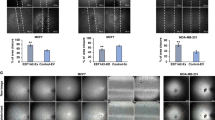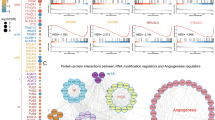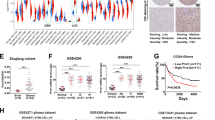Abstract
The tumour suppressor p53, involved in DNA repair, cell cycle arrest and apoptosis, also inhibits blood vessel formation, that is, angiogenesis, a process strongly contributing to tumour development. The p53 gene expresses 12 different proteins (isoforms), including TAp53 (p53 (or p53α), p53β and p53γ) and Δ133p53 isoforms (Δ133p53α, Δ133p53β and Δ133p53γ). The Δ133p53α isoform was shown to modulate p53 transcriptional activity and is overexpressed in various human tumours. However, its role in tumour progression is still unexplored. In the present study, we examined the involvement of Δ133p53 isoforms in tumoural angiogenesis and tumour growth in the highly angiogenic human glioblastoma U87. Our data show that conditioned media from U87 cells depleted for Δ133p53 isoforms block endothelial cell migration and tubulogenesis without affecting endothelial cell proliferation in vitro. The Δ133p53 depletion in U2OS osteosarcoma cells resulted in a similar angiogenesis blockade. Furthermore, using conditioned media from U87 cells ectopically expressing each Δ133p53 isoform, we determined that Δ133p53α and Δ133p53γ but not Δ133p53β, stimulate angiogenesis. Our in vivo data using the chicken chorio-allantoic membrane and mice xenografts establish that angiogenesis and growth of glioblastoma U87 tumours are inhibited upon depletion of Δ133p53 isoforms. By TaqMan low-density array, we show that alteration of expression ratio of Δ133p53 and TAp53 isoforms differentially regulates angiogenic gene expression with Δ133p53 isoforms inducing pro-angiogenic gene expression and repressing anti-angiogenic gene expression.
This is a preview of subscription content, access via your institution
Access options
Subscribe to this journal
Receive 50 print issues and online access
$259.00 per year
only $5.18 per issue
Buy this article
- Purchase on Springer Link
- Instant access to full article PDF
Prices may be subject to local taxes which are calculated during checkout






Similar content being viewed by others
References
Bourdon JC . p53 and its isoforms in cancer. Br J Cancer 2007; 97: 277–282.
Bourdon JC, Fernandes K, Murray-Zmijewski F, Liu G, Diot A, Xirodimas DP et al. p53 isoforms can regulate p53 transcriptional activity. Genes Dev 2005; 19: 2122–2137.
Chen J, Ng SM, Chang C, Zhang Z, Bourdon JC, Lane DP et al. p53 isoform delta113p53 is a p53 target gene that antagonizes p53 apoptotic activity via BclxL activation in zebrafish. Genes Dev 2009; 23: 278–290.
Aoubala M, Murray-Zmijewski F, Khoury MP, Fernandes K, Perrier S, Bernard H et al. p53 directly transactivates Delta133p53alpha, regulating cell fate outcome in response to DNA damage. Cell Death Differ 2011; 18: 248–258.
Fujita K, Mondal AM, Horikawa I, Nguyen GH, Kumamoto K, Sohn JJ et al. p53 isoforms Delta133p53 and p53beta are endogenous regulators of replicative cellular senescence. Nat Cell Biol 2009; 11: 1135–1142.
Teodoro JG, Evans SK, Green MR . Inhibition of tumor angiogenesis by p53: a new role for the guardian of the genome. J Mol Med 2007; 85: 1175–1186.
Fraisl P, Mazzone M, Schmidt T, Carmeliet P . Regulation of angiogenesis by oxygen and metabolism. Dev Cell 2009; 16: 167–179.
Pouyssegur J, Dayan F, Mazure NM . Hypoxia signalling in cancer and approaches to enforce tumour regression. Nature 2006; 441: 437–443.
Dameron KM, Volpert OV, Tainsky MA, Bouck N . Control of angiogenesis in fibroblasts by p53 regulation of thrombospondin-1. Science 1994; 265: 1582–1584.
Folkman J . Tumor suppression by p53 is mediated in part by the antiangiogenic activity of endostatin and tumstatin. Sci STKE 2006; 2006: pe35.
Galy B, Creancier L, Zanibellato C, Prats AC, Prats H . Tumour suppressor p53 inhibits human fibroblast growth factor 2 expression by a post-transcriptional mechanism. Oncogene 2001; 20: 1669–1677.
Pal S, Datta K, Mukhopadhyay D . Central role of p53 on regulation of vascular permeability factor/vascular endothelial growth factor (VPF/VEGF) expression in mammary carcinoma. Cancer Res 2001; 61: 6952–6957.
Ravi R, Mookerjee B, Bhujwalla ZM, Sutter CH, Artemov D, Zeng Q et al. Regulation of tumor angiogenesis by p53-induced degradation of hypoxia-inducible factor 1alpha. Genes Dev 2000; 14: 34–44.
Ueba T, Nosaka T, Takahashi JA, Shibata F, Florkiewicz RZ, Vogelstein B et al. Transcriptional regulation of basic fibroblast growth factor gene by p53 in human glioblastoma and hepatocellular carcinoma cells. Proc Natl Acad Sci USA 1994; 91: 9009–9013.
Giuriato S, Ryeom S, Fan AC, Bachireddy P, Lynch RC, Rioth MJ et al. Sustained regression of tumors upon MYC inactivation requires p53 or thrombospondin-1 to reverse the angiogenic switch. Proc Natl Acad Sci USA 2006; 103: 16266–16271.
Naumov GN, Akslen LA, Folkman J . Role of angiogenesis in human tumor dormancy: animal models of the angiogenic switch. Cell Cycle 2006; 5: 1779–1787.
Wong ML, Prawira A, Kaye AH, Hovens CM . Tumour angiogenesis: its mechanism and therapeutic implications in malignant gliomas. J Clin Neurosci 2009; 16: 1119–1130.
Marcel V, Vijayakumar V, Fernandez-Cuesta L, Hafsi H, Sagne C, Hautefeuille A et al. p53 regulates the transcription of its Delta133p53 isoform through specific response elements contained within the TP53 P2 internal promoter. Oncogene 2010; 29: 2691–2700.
Hagedorn M, Javerzat S, Gilges D, Meyre A, de Lafarge B, Eichmann A et al. Accessing key steps of human tumor progression in vivo by using an avian embryo model. Proc Natl Acad Sci USA 2005; 102: 1643–1648.
Khoury MP, Bourdon JC . p53 Isoforms: an intracellular microprocessor? Genes Cancer 2011; 2: 453–465.
Bourdon JC, Khoury MP, Diot A, Baker L, Fernandes K, Aoubala M et al. p53 mutant breast cancer patients expressing p53gamma have as good a prognosis as wild-type p53 breast cancer patients. Breast Cancer Res 2011; 13: R7.
Davidson WR, Kari C, Ren Q, Daroczi B, Dicker AP, Rodeck U . Differential regulation of p53 function by the N-terminal DeltaNp53 and Delta113p53 isoforms in zebrafish embryos. BMC Dev Biol 2010; 10: 102.
Nakagawa T, Takahashi M, Ozaki T, Watanabe Ki K, Todo S, Mizuguchi H et al. Autoinhibitory regulation of p73 by Delta Np73 to modulate cell survival and death through a p73-specific target element within the Delta Np73 promoter. Mol Cell Biol 2002; 22: 2575–2585.
Ohgaki H, Kleihues P . Genetic pathways to primary and secondary glioblastoma. Am J Pathol 2007; 170: 1445–1453.
Ebos JM, Lee CR, Cruz-Munoz W, Bjarnason GA, Christensen JG, Kerbel RS . Accelerated metastasis after short-term treatment with a potent inhibitor of tumor angiogenesis. Cancer Cell 2009; 15: 232–239.
Paez-Ribes M, Allen E, Hudock J, Takeda T, Okuyama H, Vinals F et al. Antiangiogenic therapy elicits malignant progression of tumors to increased local invasion and distant metastasis. Cancer Cell 2009; 15: 220–231.
Sirven A, Ravet E, Charneau P, Zennou V, Coulombel L, Guetard D et al. Enhanced transgene expression in cord blood CD34(+)-derived hematopoietic cells, including developing T cells and NOD/SCID mouse repopulating cells, following transduction with modified trip lentiviral vectors. Mol Ther 2001; 3: 438–448.
Bossard C, Van den Berghe L, Laurell H, Castano C, Cerutti M, Prats AC et al. Antiangiogenic properties of fibstatin, an extracellular FGF-2-binding polypeptide. Cancer Res 2004; 64: 7507–7512.
Jensen MM, Jorgensen JT, Binderup T, Kjaer A . Tumor volume in subcutaneous mouse xenografts measured by microCT is more accurate and reproducible than determined by 18F-FDG-microPET or external caliper. BMC Med Imag 2008; 8: 16.
Saidi A, Javerzat S, Bellahcene A, De Vos J, Bello L, Castronovo V et al. Experimental anti-angiogenesis causes upregulation of genes associated with poor survival in glioblastoma. Int J Cancer 2008; 122: 2187–2198.
Acknowledgements
We thank A Delluc-Clavières and F Pujol for technical assistance, Y Barreira, S Legonidec (animal production and phenotyping facilities of ANEXPLO platform, Inserm US006), F Gross (Vector facility), J-J Maoret (GeT TQ plateau of the Genotoul Genome-Transcriptome platform), M Pucelle (CAM facility) and C Touriol (ABAE and HUVEC cells). This work was supported by grants from Association pour la Recherche sur le Cancer, Cancéropole GSO, INCA, Fondation de l′Avenir, Association Française contre les Myopathies (AFM). HB had a fellowship from the Ligue Nationale Contre Le Cancer, then from the ARC. BGS had a postdoc fellowship from the Fondation pour la Recherche Médicale, NA had a thesis fellowship from AFM. DPL and JCB were supported by Cancer Research UK (grant number: C8/A6613).
Author information
Authors and Affiliations
Corresponding author
Ethics declarations
Competing interests
The authors declare no conflict of interest.
Additional information
Supplementary Information accompanies the paper on the Oncogene website
Supplementary information
Rights and permissions
About this article
Cite this article
Bernard, H., Garmy-Susini, B., Ainaoui, N. et al. The p53 isoform, Δ133p53α, stimulates angiogenesis and tumour progression. Oncogene 32, 2150–2160 (2013). https://doi.org/10.1038/onc.2012.242
Received:
Revised:
Accepted:
Published:
Issue Date:
DOI: https://doi.org/10.1038/onc.2012.242
Keywords
This article is cited by
-
Porcine model elucidates function of p53 isoform in carcinogenesis and reveals novel circTP53 RNA
Oncogene (2021)
-
Δ133p53β isoform pro-invasive activity is regulated through an aggregation-dependent mechanism in cancer cells
Nature Communications (2021)
-
Functional interplay between p53 and Δ133p53 in adaptive stress response
Cell Death & Differentiation (2020)
-
The Δ133p53β isoform promotes an immunosuppressive environment leading to aggressive prostate cancer
Cell Death & Disease (2019)
-
∆133p53 isoform promotes tumour invasion and metastasis via interleukin-6 activation of JAK-STAT and RhoA-ROCK signalling
Nature Communications (2018)



